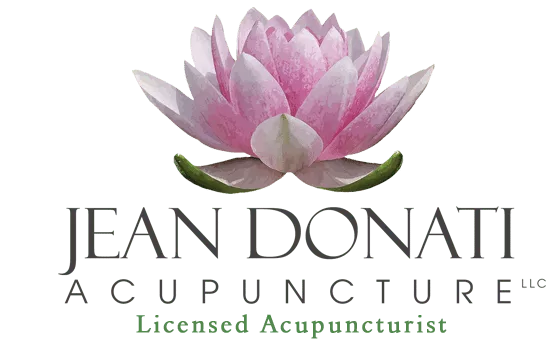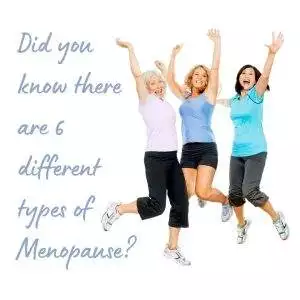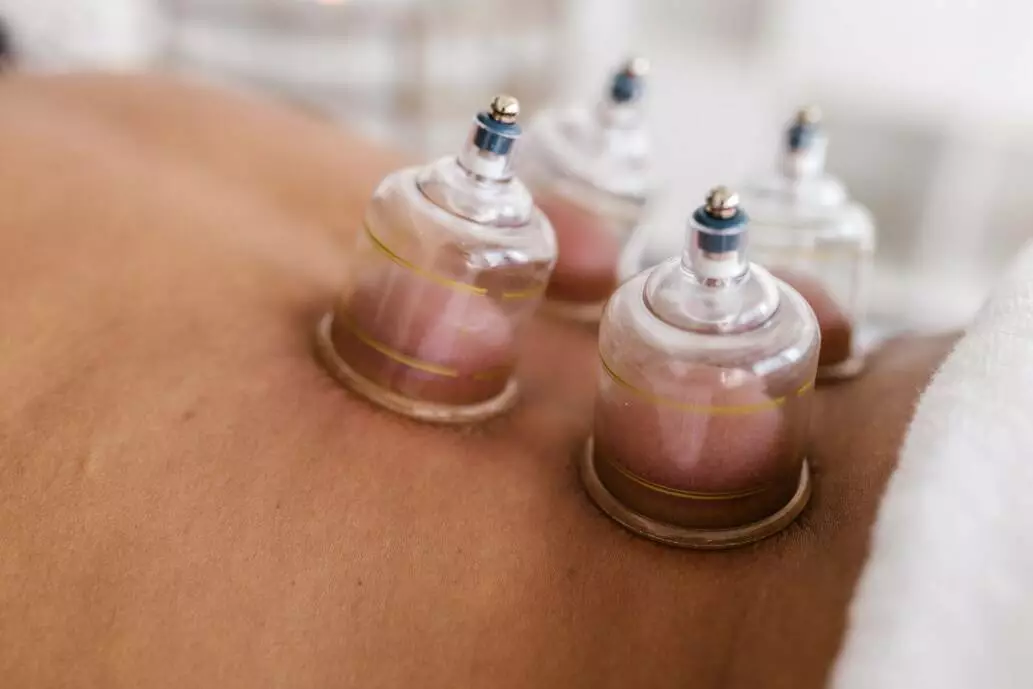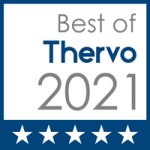- Call for a FREE Consultation
410-984-3700 - Sign up to receive news and updates and get my free report:“The Top 10 Reasons to Try Acupuncture”

- Unsubscribe at any time.

-
 Jean Donati Acupuncture604 E. Joppa RD
Jean Donati Acupuncture604 E. Joppa RD
Towson, MD 21286410-984-3700 -
Latest Articles:
- • Spring Clean Your Way to Better Health •
- • 5 Healthy Ways to Embrace the Spring Season •
- • Fun Things to do this Spring •
Depression
What is Cupping and How Is It Related to Acupuncture?
Cupping is a form of Traditional Chinese Medicine (TCM) therapy that dates back to ancient Egyptian, Middle Eastern and Chinese cultures as far back as 300A.D. TCM philosophy believes that pain results from the blockage of Qi, blood, or energy. You have all heard me say in relationship to acupuncture: “Where there’s stagnation, there is pain. Where there is free flow there is no pain.”
Cupping, like acupuncture is a method of clearing this blockage to restore the body’s natural flow of energy. This is beneficial for health promotion, prophylaxis, and treatment of disorders such as back pain, knee pain, asthma, carpal tunnel syndrome, migraines, as well as high blood pressure.
Recent researches show that cupping therapy helps to:
- Reduce muscle pain
- Improve blood circulation, promote cell repair and increase muscle relaxation
- Assist the lymphatic system to drain excess fluids and toxins
Cupping has many musculoskeletal benefits. It is helpful for chronic lower back pain, neck pain and fibromyalgia. In addition, digestive symptoms such as bloating, gastric reflux and constipation conditions can be eased with cupping. Overall recovery from cough, asthma and the common cold can be improved with cupping as well as acupuncture.
In a cupping session, inverted cups made of bamboo, glass, silicone or plastic are applied to the acupuncture points on the body to create suction. The suction of the cups pulls the skin upward as the suction increases. The suction opens up energy pathways in a similar way to acupuncture and is often used in conjunction with acupuncture to clear the energy channels and remove toxins from the body that are responsible for pain and disease. It has been used effectively for pain relief, increasing blood flow, chronic inflammation, enhanced relaxation, and improved quality of life.
Cupping draws fluid into the area being worked on by the suction it creates. This causes improved circulation and release of toxins. The discoloration that occurs after cupping is due to broken blood vessels just beneath the skin, much like a bruise. These marks and their color, are diagnostic of toxins being released to the upper skin layer for the body to disperse. The marks tend to fade within days to a week.
In the next article I will discuss the different types of cupping, coloration of cupping marks and their meanings. Stay Tuned!
Sources
Cleveland Clinic https://my.clevelandclinic.org/health/treatments/16554-cupping
Harvard Health Letter https://www.health.harvard.edu/blog/what-exactly-is-cupping-2016093010402)
WebMD “Cupping” https://www.webmd.com/balance/guide/cupping-therapy
https://www.thomsontcm.sg/articles/what-do-your-cupping-colours-tell-you/#:~:text=These%20cupping%20marks%20are%20discoloration,of%20stagnation%20in%20that%20area.
Gratitude’s Link with Love & Happiness
 A glass half full – grateful people have a particular view of the world and themselves. They choose to notice the positive things in the world and their own lives and have an appreciation for things that other people may take for granted. In a growing body of research, the importance of gratitude suggests that it is a cornerstone of positive psychology.
A glass half full – grateful people have a particular view of the world and themselves. They choose to notice the positive things in the world and their own lives and have an appreciation for things that other people may take for granted. In a growing body of research, the importance of gratitude suggests that it is a cornerstone of positive psychology.
Love: Research from Psychologists Dr. Robert Emmons from UC Davis and Dr. Michael McCullough from the University of Miami go so far as to say that not only does gratitude promote feelings of happiness and love but that it is also a form of love itself. Open communication is necessary for healthy relationships. People who focus on the positive qualities of their partners experience more feelings of closeness and are often more aware of their partner’s needs and wishes, resulting in healthier, happier, more intimate relationships.
In 2010, Dr. Sara Algoe of UC Berkley sampled 67 heterosexual couples who had been together for at least 3 months. The partners wrote in a diary every night for 2 weeks and recorded both their own and their partner’s thoughtful actions, their feelings toward the actions and how they felt about the relationship that day. This research found that gratitude reminds romantic partners of the quality of the relationship, the quality of the individual’s partner and enhanced feelings of closeness.
Other studies, like one by Kubacka, Finkenauer, Rusbult and Keijsers in 2011 showed that gratitude begets gratitude. Kind gestures toward a spouse led to feelings of gratitude (of course!) and that gratitude motivated the other spouse to reciprocate with kind gestures. None of that should be too surprising but the ultimate result was a positive cycle of gratitude and caring behavior that continued to increase.
5 Proven Health Benefits of Gratitude:
- Improved sleep
- Can strengthen your physiological well-being
- Longevity
- Increased Energy Levels
- Increased likelihood of physical activity
Life Satisfaction:
Ever wonder how some people continue to stay genuinely happy, even though they get hit with hardship after hardship and other people seem miserable even though they have everything anyone could ever want. Studies show it may come down to gratitude. “A key determining factor of well-being is the ability to notice, appreciate and savor the elements of one’s life”, say Dr. Emmons and Dr. McCullough. Three studies conducted by the pair looked into whether focusing on negative or neutral life events versus focusing on positive ones can lead to improved psychological and physical function. All three studies concluded that “an effective way to produce reliably higher
Is practicing gratitude a cure-all? Of course not! But research demonstrates its many benefits with no drawbacks. It is a powerful tool that can be utilized to live a good, meaningful life.
One thing to consider is being gracious with yourself. Show some gratitude to YOU, and treat yourself to an acupuncture treatment. Give us a call today!
https://positivepsychology.com/gratitude-research/
Health Benefits of Acupuncture and Yoga
The Health Benefits of Acupuncture and Yoga
 Acupuncture is an ancient healing technique originating in China over 5000 years ago. It is the process of moving qi (chee) or energy, in the body to decrease pain, facilitate health, wellness, and allow the body to heal itself. Disruption of qi energy is responsible for pain and illness in the body. By using certain acupuncture points, this energy is allowed to move freely and decrease pain and improve health.
Acupuncture is an ancient healing technique originating in China over 5000 years ago. It is the process of moving qi (chee) or energy, in the body to decrease pain, facilitate health, wellness, and allow the body to heal itself. Disruption of qi energy is responsible for pain and illness in the body. By using certain acupuncture points, this energy is allowed to move freely and decrease pain and improve health.
The practice of yoga can be traced back to Northern India 5000 years ago. It incorporates body postures, meditation, breathing and relaxation techniques all dedicated to moving prana or energy.
Acupuncture and yoga share the philosophy of connecting the body, mind, and spirit. Through the practice of acupuncture and yoga, you can experience many health benefits.
According to Johns Hopkins Medicine the benefits of acupuncture and yoga include….
*Pain relief, in particular, improving back pain.
*Easing arthritis symptoms.
*Benefiting heart health
*Relaxation for improved sleep
*Increased energy, brighter moods and mental clarity.
*Stress relief
Both and acupuncture and yoga benefit the whole person by enhancing health of multiple body systems and increasing the sense of well-being.
The World Health Organization (WHO) recognizes acupuncture to be helpful for many conditions affecting the body, mind, and spirit. These include pain, stress, nausea and vomiting, headache and sciatica, plus many more medical conditions.
Come enjoy Acupuncture with Jean Donati Acupuncture in Towson, MD., and Yoga with Janet. Your body will thank you for it.
Schedule an acupuncture appointment with Jean Donati Acupuncture in Towson, MD here https://www.East2WestMedicine.com
Schedule a virtual yoga class with Yoga with Janet here https://www.yogawithjanet.yoga/
Notes:
https://www.medicalnewstoday.com/articles/286745
https://www.hopkinsmedicine.org/health/wellness-and-prevention/9-benefits-of-yoga
https://holistic-health.org.uk/acupuncture-evidence-project-deeper-look/
https://www.medicalnewstoday.com/articles/156488#what-is-acupuncture
Six Different Types of Menopause
 Menopause is a natural decline of the Kidney Jing, or essence, according to Chinese Medicine. So, how does one prepare? Simply put, we have to be more “Yin” in our approach to life. Yin is restful and nourishing. So slowing down, taking more time for rest and finding balance is an appropriate approach.
Menopause is a natural decline of the Kidney Jing, or essence, according to Chinese Medicine. So, how does one prepare? Simply put, we have to be more “Yin” in our approach to life. Yin is restful and nourishing. So slowing down, taking more time for rest and finding balance is an appropriate approach.
See the full article below to find out more about each of the 6 types of Menopause…Which one are you?
Give us a call and together let’s discover which “type” of menopause you may be experiencing. We’ve got healthful options to support you through your healing journey. We can do this! Give us a call today.
Acupuncture_Menopause_Type_towson_MD_Jean_Donati








